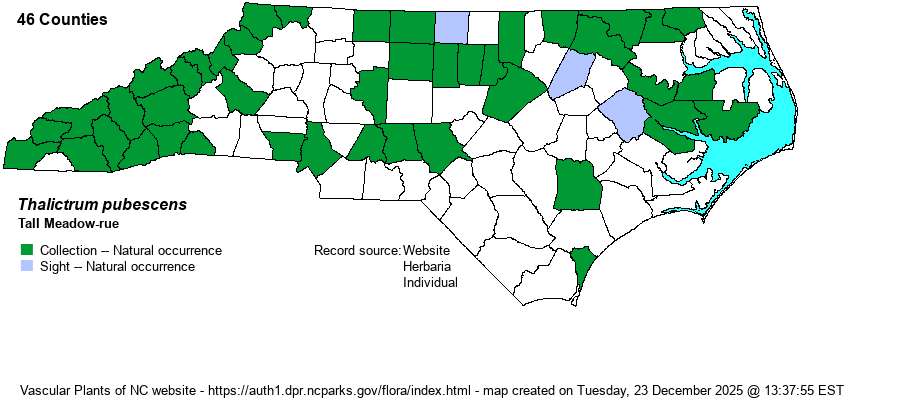| Section 6 » Order Ranunculales » Family Ranunculaceae |
Show/Hide Synonym
| taxonName | relationship | relatedTaxonName | relatedTaxonRefText | relComments |
|---|
| Thalictrum pubescens | = | Thalictrum pubescens var. pubescens | Wofford (1989) | | | Thalictrum pubescens | < | Thalictrum polygamum | Fernald (1950) | , G, RAB, S, nomen nudum | | Thalictrum pubescens | < | Thalictrum pubescens | Gleason and Cronquist (1991) | | | Thalictrum pubescens | < | Thalictrum pubescens | Godfrey and Wooten (1979, 1981) | | | Thalictrum pubescens | < | Thalictrum pubescens | Kartesz (1999) | | | Thalictrum pubescens | < | Thalictrum pubescens | | | | Thalictrum pubescens | < | Thalictrum pubescens | Flora of Virginia | | | Thalictrum pubescens | < | Thalictrum pubescens | Flora of West Virginia | | | Thalictrum pubescens | < | Thalictrum pubescens | Tamura in Kubitzki, Rohwer, & Bittrich (1993). | | | Thalictrum pubescens | < | Thalictrum pubescens | Flora of North America (1993b, 1997, 2000, 2002a, 2002b, 2003a, 2004b, 2005, 2006a, 2006b, 2006c, 2007a, 2009, 2010) | | | Thalictrum pubescens | < | Thalictrum pubescens | | | | Source: Weakley's Flora |
|
| Author | Pursh | |
| Distribution | Present throughout the Mountains, and mostly just the northern halves of the Piedmont and Coastal Plain, though there are records scattered over the last two provinces.
This is a somewhat Northern species, ranging across eastern Canada and the northern states, south to SC, AL, and MS. | |
| Abundance | Frequent in the Mountains, though not truly common. Infrequent to fairly common in the northern halves of the Piedmont and Coastal Plain. Rare to uncommon in the southern Piedmont and the southern half of the Coastal Plain. | |
| Habitat | This is a wetland Thalictrum, favoring openings in swamps, bottomlands, wet thickets, stream banks, bogs, and marshes. | |
| Phenology | Blooms from May to July, and fruits shortly after flowering. | |
| Identification | This is a quite tall species, growing to 4-5 feet tall. It is very similar to, and easily confused with, T. amphibolum, which can grow in similar habitats. Each has mainly bi-ternately divided leaflets (3 groups of 3 leaflets), each leaflet having mainly 3 lobes with the middle the widest, and lobes rounded. In this species, the leaflet undersides do not have small glands (visible with a hand lens) but are somewhat pubescent. Both have sessile stem leaves, and both have large and open panicles of small flowers -- male on one individual plant and female on a separate plant. In this species, the white filaments on the male plants radiate in all directions into a showy ball of white color, as opposed to in T. amphibolum, where the filaments on the male flowers droop, like with T. dioicum. T. coriaceum generally has wide leaflets with several teeth on each leaflet lobe, instead of 3 smoothly rounded lobes; and T. macrostylum normally has many leaflets that are entire and unlobed, plus most leaflets are narrower than 1/2-inch wide. Individuals of tall meadow-rues can often be seen on various walks, but normally you must look carefully at the leaves and flower parts to be certain what you have. | |
| Taxonomic Comments | Formerly named, such as by RAB (1968), as Thalictrum polygamum.
| |
| Other Common Name(s) | Common Tall Meadow-rue, Late Meadowrue, King-of-the-meadow | |
| State Rank | S3S4 [S4] | |
| Global Rank | G5 | |
| State Status | | |
| US Status | | |
| USACE-agcp | FACW link |
| USACE-emp | FACW link |

